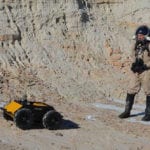 Misconceptions
Misconceptions  Misconceptions
Misconceptions  History
History 10 Amazing Roman Epitaphs
 Weird Stuff
Weird Stuff 10 Niche Subcultures That Are More Popular Than You Might Think
 Mysteries
Mysteries 10 Tragic Disappearances and Deaths in Joshua Tree National Park
 History
History 10 Ways Childhood Really Sucked in the Old West
 Music
Music 10 Name Origins of Famous Bands from the 1990s
 Religion
Religion 10 Biggest Turnarounds by the Catholic Church
 Weird Stuff
Weird Stuff 10 Unbelievable Times Laws Had Unintended Consequences
 Humans
Humans Ten Historic Women Who Deserve Way More Credit Than They Got
 Movies and TV
Movies and TV 10 Films That Spawned Major Lawsuits
 Misconceptions
Misconceptions 10 Phony Myths and Urban Legends That Just Won’t Die
 History
History 10 Amazing Roman Epitaphs
 Weird Stuff
Weird Stuff 10 Niche Subcultures That Are More Popular Than You Might Think
Who's Behind Listverse?

Jamie Frater
Head Editor
Jamie founded Listverse due to an insatiable desire to share fascinating, obscure, and bizarre facts. He has been a guest speaker on numerous national radio and television stations and is a five time published author.
More About Us Mysteries
Mysteries 10 Tragic Disappearances and Deaths in Joshua Tree National Park
 History
History 10 Ways Childhood Really Sucked in the Old West
 Music
Music 10 Name Origins of Famous Bands from the 1990s
 Religion
Religion 10 Biggest Turnarounds by the Catholic Church
 Weird Stuff
Weird Stuff 10 Unbelievable Times Laws Had Unintended Consequences
 Humans
Humans Ten Historic Women Who Deserve Way More Credit Than They Got
 Movies and TV
Movies and TV 10 Films That Spawned Major Lawsuits
Top 10 Facts That Prove Ants Are Evil
With species numbering in the ten thousands, ants are all around us. Ant populations are highest in tropical rain forests, but they can be found anywhere the world. While ants are incredibly organized and successful creatures, they’re also just plain evil.
10Ants Kill Old Zombie Friends

In South America, there is a species of carpenter ant that can become infected with the spores of a fungus. As the spore grows, it controls the ant’s brain, turning it into a kind of zombie. The fungus forces the ant to climb a leaf, chomp down on the leaf, and then die. This action allows the fungus to grow from the ant’s body onto the leaf.[1]
In a study of this fungus, researchers found that healthy ants will keep the spores away from the colony by getting rid of infected ants. Healthy ants carry diseased ants far away from the colony and strand them, or they destroy the body of a dead ant with the disease. These ants also look out for their interests by sending the older ants of the colony to do all the scary work in the outside world, while younger, fitter ants look after the babies in the nest. We can safely conclude that ants force their elderly to risk their lives to gather food for the entire colony, and then destroy any ants that fall ill.
9They Destroy Electrical Devices

Nothing creates fear like the name “crazy ant.” The name may sound silly, but the yellow and Tawny varieties of these ants are horrific. Yellow crazy ants took root on Christmas Island, near Australia, and caused an overwhelming infestation. To this day, they’re a threat to the red crabs that migrate on this island.[2]
Tawny crazy ants, also deemed “Raspberry” ants after Tom Raspberry, are just as fearful. Raspberry is an exterminator who discovered the ants. He has campaigned for government help with the infestation in the Houston area, but has had no luck. Both types of crazy ants create “super-colonies” with multiple queens, making them nearly impossible to exterminate. Even when the ants are dead, piles of these ants have been found in every nook and cranny of homes and businesses. They can also kill animals. The ants’ odd attraction to electricity has ruined television sets, wiring and several other electrical devices. No wonder they’re called crazy.
8They Own Slaves

Slavery is illegal, brutal, and inhumane, as we all know, but who would have thought insects participated in it? There are ants known as “slave makers,” whose jaws are large and created for fighting, not feeding. As such, they cannot feed themselves. These ants will invade a different colony of regular ants, kidnap newborn ants from the queen, and raise them to be their servants.[3] These are insects that can barely see, who depend mostly on scent for communication, but they’re intelligent enough to get someone else to feed them while they lounge around.
As bad as this practice is, the ants being raided can be just as terrible. Other ants have to be able to imitate the colony’s particular smell, otherwise the ants will know that there is an intruder and attack. Ants protecting their nest will surround, sting, and then paralyze the intruder, before ripping it to shreds with their powerful jaws.
7They Trap Victims And Chop Them

One species of ant found in the Amazon is able to create booby traps for larger insects. These ants use leaves to weave a net with large holes. Once their prey steps into the holes of the net, the ants attack the insect’s limbs with their jaws and hold the creature in place.[4]
Other workers then come in and sting the victim to make absolutely sure it won’t get away, because ripping the insect’s limbs off is apparently not enough. These ants have been known to capture locusts and other insects that are several times their own size. After cutting the victim into bite-size pieces, the ants carry their prize back to the colony for a feast.
6They Steal Our Warmth

While many ants die in colder temperatures, Pharaoh ants have found a way to survive during the winter months. From their point of view, why freeze to death outside when humans have perfectly functional heating and ventilation systems? Pharaoh ants are notorious for inhabiting heating systems, as well as other crevices in homes.[5]
Some of the ants we have read about create “super-colonies” with multiple queens, but Pharaoh ants can do that and move an entire colony quickly away from a nest that has been compromised. These ants can wreak havoc in public places like hospitals by contaminating tools and surgical areas. Though the little beasts are certainly clever by taking advantage of artificial heat, they’re also definitely evil.
5Fire Ants Take Down Deer

Of all the terrible ants in the world, probably the most awful is the fire ant. Woe to the unfortunate animal or human that disturbs a fire ant nest because these demons attack with a vengeance. Fire ants can climb vertical surfaces very fast, so stepping on a fire ant nest can literally leave a person with ants in their pants. These ants leave a painful sting, often raising a white bump on the skin. In rare cases, fire ant stings can kill or send a victim into shock, but most of the time they just leave a person very sore and unhappy.[6]
However, animal victims of fire ants are not so lucky. Wild animals such as birds, lizards, and even deer have been killed by many fire ant stings. Measures have been taken to subdue these ants and protect the animals they kill, but the ants are so numerous and widespread that their populations are difficult to control.
4Army Ants Scare Elephants

Army ants are among the most notorious ants in the world. Inhabiting rain forest areas in South America and Africa, these ants do not settle in one place like most types of ants. They make a temporary nest by linking their bodies together to create a protective covering for the queen while she lays eggs.[7] When the babies are ready to move, these ants go on the rampage, fanning out in a destructive line that eats anything in the way. Army ants have long, scary mandibles that can literally shred flesh.
Singly, the ants cannot do much, but in a large group, they can take down prey several hundred times bigger than themselves. Large animals and even people have been murdered by these ants. The elephant, one of the largest land mammals in the world, has been known to flee the face of army ants. A few African tribes control the pests by dousing the front lines with gas or kerosene and setting them on fire. This tactic creates confusion for the ants further back on the lines, but nothing will eradicate them completely. The best policy is usually just to run away as fast as possible.
3Ghost Ants End Whole Ecosystems

Like the Pharaoh ant, ghost ants live indoors or outdoors and can create massive nests with multiple queens, making them very difficult to eliminate. The main vice of this species is their ability to disrupt or even destroy entire ecosystems. Because they’re so good at food hunting, these ants might drive other animals from their habitat or wipe out entire populations of plants.[8]
Named for their ghostly looking exoskeleton, these tiny ants also invade human habitats and food sources. Apparently, they like bags of potato chips, which could be really gross for whoever gets the unlucky bag. Another lovely habit of this species is their tendency to nest in flowerpots or under things left out on the lawn, that could make for a nasty surprise when doing yard work.
2Leaf-Cutter Ants Farm Their Prey

Pesticides are taken off the market due to expensive relabeling procedures, making the leaf-cutter ant very difficult to control in the United States. Thankfully, these ants are not carnivores, but the leaves they take from plants can destroy home gardens or landscaping shrubs. These ants are hoarders, so they take leaf cuttings back to their nests and leave them there to be eaten by fungus. This fungus then becomes food for the entire colony.[9]
Because of the unique structure of leaf-cutter nests, these nests can cause areas of a lawn to cave in, or create massive mounds that disrupt the growth of greenery. If these ants manage to get under the foundation of a house, they could crack the cement and undermine the entire structure. Leaf-cutters seem to enjoy red flowers or anything highly scented, so it is a good idea to keep those away from a house or out of a garden.
1Carpenter Ants Collapse Houses

Probably the most common ant pest is the carpenter ant. Properly named for their love of wood, these ants typically live in any kind of wooden structure. Since most houses are made of wood, carpenter ants can become a big problem for homeowners. These pests burrow into wood, much like termites, and can easily damage an entire home.[10]
The only way to get rid of these ants is to track down the nest, but that’s definitely easier said than done. One way is to feed some stray ants and follow them home, which can get boring really fast. Another way is to search for wood that might be damp, like window or door frames or spaces behind appliances, and tap it to listen for a crackling or hollow sound. Even if the nest can be located, a person would have to further damage the walls by drilling holes to pump insecticide into the nest. Carpenter ants are hard to find and hard to kill, making them most definitely evil.
Brittiany West is a self-published author and freelance writer. Check out her work at Brittiany West Books.








